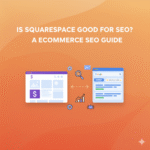If you’re using Squarespace, one thing is sure—you love clean design, simple tools, and a hassle-free website-building experience. But once the site is ready, the next question everyone asks is: How do I improve my SEO on Squarespace?
Squarespace is a great platform, but SEO doesn’t happen on its own. You need to tweak, optimize, and structure your website the right way so Google can understand it, rank it, and send you traffic.
This guide is written in the simplest way possible, so even if you’re a beginner, you can follow every step without confusion. Let’s dive into everything you need to know to improve SEO on Squarespace.
What Makes Squarespace Different for SEO?
Squarespace is designed for non-technical users. So instead of plugins, coding, and advanced backend settings (like WordPress), it gives you a clean, built-in SEO system. This is good for beginners — but it also means you need to use these built-in features properly.
Squarespace already handles things like:
- Mobile responsiveness
- Automatic SSL
- Clean URLs
- Image compression
- Built-in sitemap
- Structured layout
But for good rankings, YOU must optimize the on-page content, image alt text, website structure, and performance.
1. Optimize Your Page Titles and Meta Descriptions
This is the most important SEO step in Squarespace. It tells Google what your page is about.
How to Write Good Page Titles
A good title should clearly explain the page topic and include your keyword.
Bad Title:
“Services”
Better Title:
“Digital Marketing Services for Small Businesses | Affordable & Effective”
Steps in Squarespace:
Pages → Click the gear icon → SEO → Page Title
Keep titles:
- Clear
- Keyword-based
- 50–60 characters
- Easy for humans to understand
Write Meta Descriptions That Attract Clicks
Meta descriptions don’t directly affect ranking, but they improve click-through rate (CTR).
Example meta description:
“Get expert digital marketing services designed for small businesses. Simple pricing, proven strategies, and results-focused solutions.”
Steps in Squarespace:
Pages → Settings → SEO → Meta Description
Keep it:
- 150–160 characters
- Clear and helpful
- Naturally keyword-rich
2. Use Clean, Short, SEO-Friendly URLs
Squarespace lets you edit URL slugs easily. Use this feature smartly.
Bad URLs:
- /services-page-digital-marketing-2025
- /blog/long-title-with-random-words
Good URLs:
- /digital-marketing
- /wedding-photography
- /seo-tips
How to edit:
Pages → Settings → URL Slug
Keep URLs:
- Short
- Lowercase
- Without stop-words (the, of, and, etc.)
- Keyword-friendly
3. Improve Your Website Speed (Major Ranking Factor)
Speed is a huge SEO ranking factor, and Squarespace gives you a head start — but you can make it even faster.
Compress Images Before Uploading
Even though Squarespace compresses images, uploading lighter images boosts performance.
Use tools like:
- TinyPNG
- Canva optimized export
- ImageOptim
Best practice:
- Keep image size under 200–300 KB
- Use JPEG for photos
- Use PNG for graphics
- Use WebP if possible
Avoid Heavy Videos on Pages
Video backgrounds and motion effects slow down load time.
Better option:
Upload videos on YouTube → Add YouTube embed → Faster loading
Keep Design Simple
Minimal design = faster loading = better SEO.
Avoid:
- Too many animations
- Multiple video banners
- Overuse of parallax effects
- Extra code blocks
4. Use Image Alt Text Properly
Google can’t read images; it reads your alt text.
Alt text helps with:
- SEO
- Image ranking
- Accessibility
Bad alt text:
“IMG_2023.jpg”
Good alt text:
“Bride posing for a wedding photoshoot at sunset”
Where to add:
Click image → Edit → Image Alt Text
Keep alt text:
- Descriptive
- Keyword-friendly
- Short and clear
5. Create and Maintain a High-Quality Blog
Content is the backbone of SEO.
Squarespace’s blogging tool is simple and clean. Use it to publish quality content regularly.
Types of content to publish:
- How-to guides
- Industry insights
- Problem-solving articles
- FAQs
- Tutorials
- Product comparisons
- Tips and strategies
Blogging helps:
- Build authority
- Target multiple keywords
- Get indexed faster
- Improve organic traffic
Pro tip:
Write one blog per week or at least 2 per month.
Optimize Every Blog Post
For each blog post:
- Use a keyword in title
- Add internal links
- Add alt text to images
- Write a clean meta description
- Use short paragraphs
This improves readability and ranking.
6. Improve Your Site Navigation and Structure
Google loves simple website structures.
Your navigation should be crystal clear, like:
- Home
- About
- Services
- Portfolio
- Blog
- Contact
Avoid:
- Too many categories
- Deep hidden pages
- Unnecessary dropdowns
- Empty pages
Simple structure = faster crawling + better ranking.
7. Build Internal Linking (Very Important!)
Internal links help Google understand your website.
Examples:
- Link your homepage to service pages
- Link blog posts to related articles
- Link product pages to buying guides
Benefits:
- Improves crawl depth
- Boosts page authority
- Keeps visitors on your site longer
Squarespace makes linking easy with inline text links.
8. Connect Google Search Console and Submit Sitemap
This is one of the most important SEO steps.
Steps to Connect:
- Go to Settings → Marketing → Google Search Console
- Verify your website
- Submit your sitemap:
yourdomain.com/sitemap.xml
Search Console helps you:
- See ranking keywords
- Fix indexing issues
- Monitor impressions & clicks
- Track page performance
9. Use Basic Schema Markup Where Possible
Squarespace doesn’t provide automatic advanced schema, but you can manually add simple schema.
You should add:
- Local Business Schema
- Article Schema (for blogs)
- FAQ Schema
- Product Schema (if selling online)
Steps:
Page → Settings → Advanced → Header Code Injection
Schema helps Google understand your page better and improves SEO.
10. Add 301 Redirects When Changing URLs
If you change a page URL, you must redirect the old one, or you’ll lose SEO value.
Steps:
Settings → Advanced → URL Mappings
Example redirect:
/old-url → /new-url 301
This protects your SEO and prevents 404 errors.
11. Leverage Social Sharing to Improve Visibility
SEO is not just about Google. Social signals indirectly support credibility.
Squarespace has built-in sharing tools, so use them.
Promote your content on:
- Twitter (X)
More shares = More visibility = More backlinks (naturally)
12. Use Keywords Where They Matter
You don’t need to keyword-stuff your website; just use keywords naturally.
Place them in:
- Titles
- First paragraph
- Headings
- URLs
- Image alt text
- Meta descriptions
Example for a wedding photographer:
Main keyword: wedding photographer
You can use:
“Affordable wedding photographer”
“Candid wedding photography”
“Wedding photoshoot ideas”
Use them smoothly—not forcefully.
13. Improve User Experience (UX)
Google ranks websites that give users a good experience.
To improve UX:
- Use large, readable fonts
- Keep paragraphs short
- Add spacing between sections
- Use clear CTAs
- Keep page layout simple
- Make forms easy to fill
A clean design = better engagement = better SEO.
14. Add Backlinks Through Smart Strategies
Backlinks are essential for ranking.
Simple ways to build backlinks:
- Write guest posts
- Collaborate with bloggers
- List your site in directories
- Share useful content
- Answer questions on Quora
- Participate on Reddit
Squarespace doesn’t give special tools for backlinks — but backlinks work the same anywhere.
15. Update Your Website Regularly
Google prefers active websites.
You can update by:
- Adding new blogs
- Updating existing pages
- Changing photos
- Improving service pages
- Making content clearer
Regular updates = constant crawling from Google.
16. Avoid Keyword Stuffing or Over-Optimization
Squarespace users often try to over-optimize because they don’t have plugins like Yoast.
Avoid:
- Repeating keywords
- Writing unnatural sentences
- Overusing alt text
- Using too many headings
Keep your tone natural and helpful.
Short Final Summary
To improve SEO on Squarespace, optimize titles, URLs, meta descriptions, image alt text, and content. Compress images, speed up pages, build clear navigation, connect Google Search Console, write consistent blogs, add internal links, use schema markup, build backlinks, and maintain regular updates. Squarespace gives a strong foundation you just need to optimize it the right way.
Discover more from PratsDigital
Subscribe to get the latest posts sent to your email.


Pingback: How to Add SEO Keywords to Squarespace? - PratsDigital